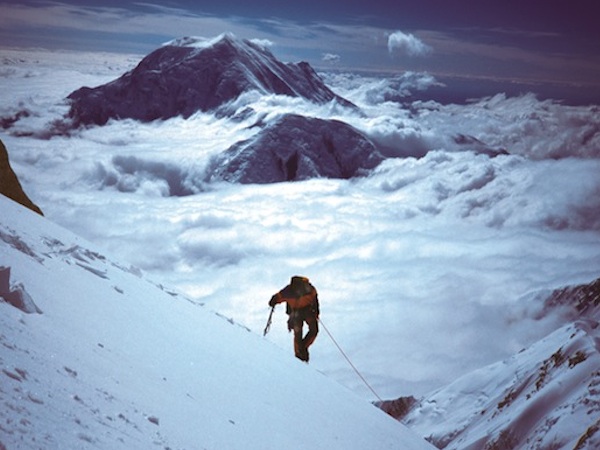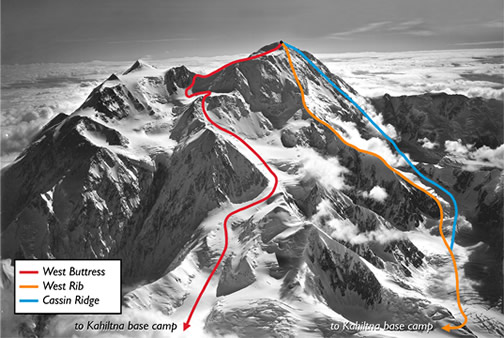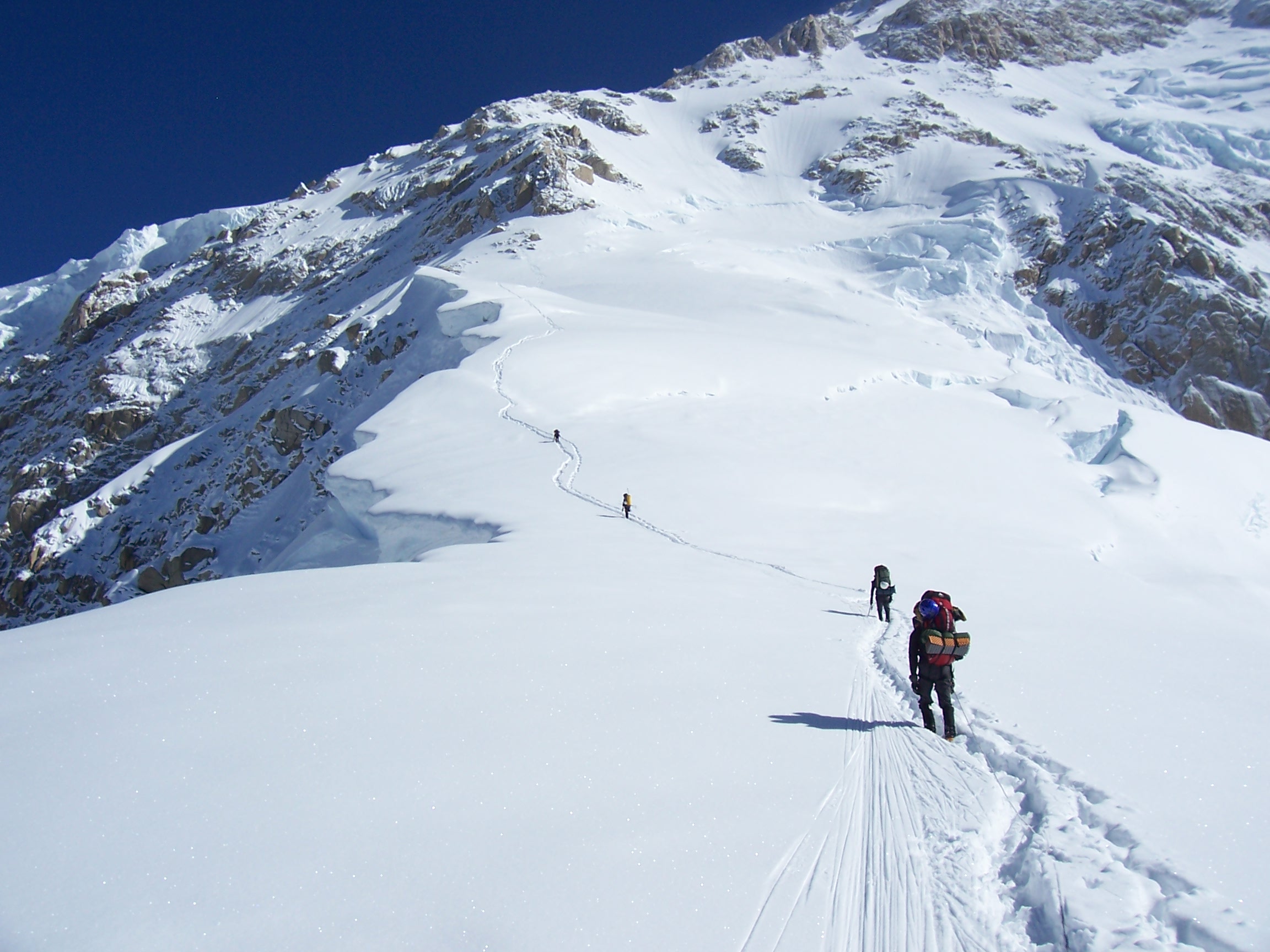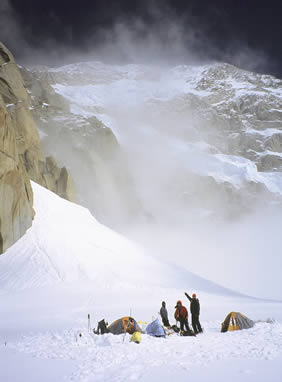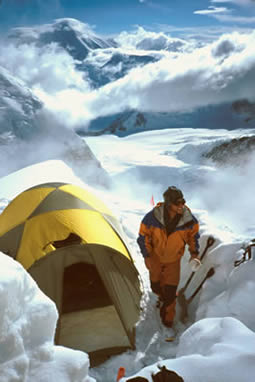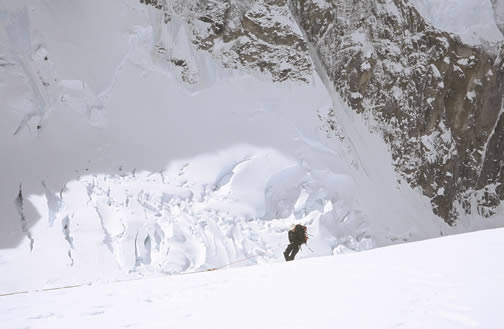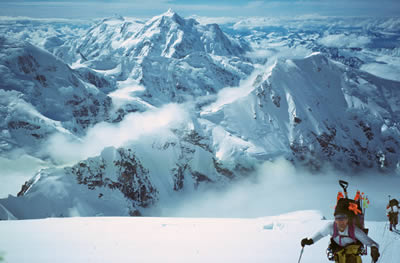Denali Expedition - West Rib Overview A climber pauses during the physical ascent of the West Rib. AAI Collection
Denali's West Rib route is a step up in difficulty from the West Buttress, the route normally used to climb Denali
Most parties choose to do the West Rib Cutoff , which ascends the safer standard West Buttress route until 14,200 feet, where the normal Camp 3 is located along with an NPS presence and medical tent. At 14,200 feet the route departs from the crowds of the West Buttress and takes a cut-off to the West Rib, gaining the ridge at around 15,700 feet. The route then ascends the upper ridge, making one additional camp on the way to the summit.
Prerequisites
Completion of technical snow and ice routes to Grade 4 to 5 (TD, TD+)
Experience with glacier travel and crevasse rescue
Successful climbing at altitude above 16,000 feet (4877 m)
Winter mountaineering experience
Outstanding physical condition
Denali Expedition - West Rib The AAI Approach As in other parts of the world, AAI expeditions in Alaska are run with small groups of climbers who have carefully prepared for their objective. The Institute takes a team approach to its climbs, and expedition members are expected to take responsibility for themselves and a share of responsibility for the overall operation of the expedition. We do not accept climbers who are under experienced and who need to be "hauled" up and down the mountain. Trying to push ill-prepared climbers up the peak is what keeps so many guided and unguided groups from succeeding on Denali.
The Institute gives its clients careful and detailed counsel in their preparations for climbing objectives and, when appropriate, has them first achieve intermediate goals. Climbs on Denali obviously involve many factors that we cannot control, among them temperature, wind, snowfall, and changeable climbing conditions. The key to success therefore lies in doing an excellent job on those areas in which a climber has some control: skill in dealing with cold conditions, skill in climbing at an appropriate technical level, and personal conditioning. To develop these abilities and then to combine them with a carefully designed and guided itinerary is the most direct line to safety and success.
AAI expeditions enjoy a rate of safety and success rarely matched by other teams. With well-prepared climbers, we do not have to rely on perfect conditions in order to move. Able to remain poised high on the mountain in poor conditions, our teams often make successful summit bids in small windows of good weather when other teams are out of position. AAI doesn't pretend to guarantee good health, good weather, or success on these expeditions, but we are committed to building strong teams and creating high potential for safe and successful climbs. The average individual success rate on Denali is 54% overall and 59% in guided groups other than AAI. The Institute's success rate for individuals for the last ten years is 70%, and for expeditions it is 75%.
Climbers descending after a successful climb of the West Rib.
AAI has the highest level of commitment to environmental protection and restoration, and on all expeditions and instructional programs we teach and follow Leave No Trace ethics and practices for travel, camping, and climbing. The Institute has been a leader in the conscientious use of wilderness environments, including both remote and popular areas of Denali and the Alaska Range. Each year the National Park Service presents "Denali Pro" awards to individuals who have made major contributions to protecting the mountain. Twenty AAI guides and clients have had the honor of receiving this highest Denali National Park and Preserve award since its inception four years ago.
With regard to expedition processes, we make five to seven camps as we climb alpine style, moving all camps higher as we go and leaving none established above or below. It is not uncommon for temperatures high on the mountain to fall as low as -30F, but at lower elevations daytime temperatures on the glacier can reach as high as 70F, so there we sometimes sleep in the day and ferry loads at night when temperatures are between 0F and 15F. The night's cold improves conditions under foot, and we still have adequate light because of the extreme northern latitude. Double carries are done during the first part of the expedition to ease the work and to help with acclimatization.
All expeditions begin with a meeting and orientation in Anchorage. We spend one night there, then travel by van the next morning to the small town of Talkeetna. There we repack our equipment, meet our ski plane pilots, and as soon as possible, make the beautiful flight to the Kahiltna Glacier at 7300 feet. Soon after our arrival and a review of glacier travel procedures, we begin moving to our first camp.
Denali Expedition - West Rib Route Options Climbing the entrance couloir to the West Rib. AAI Collection
Upper West Rib Variation
The Upper West Rib provides for a fantastic adventure on a classic line while still providing you with many of the aesthetics found on the West Buttress. On this climb, out team will ascent the standard West Buttress route up to Camp III at 14,200 feet. From there, we will climb up the West Rib Cut-Off to join the upper Rib.
High camp on the West Rib.
After arriving at Camp III, most teams will make an acclimatization climb up to the 17,200-foot West Buttress camp. There they will leave a cache set-up for their descent a few days later.
After waiting for an appropriate weather window at Camp III, the team will work its way up the Cut-Off to join the ridge crest at 15,700 feet. Once the crest is reached, the climbing is absolutely fantastic. The team will climb a steep and sustained couloir to a protected camp at 16,400 feet.
On summit day, we will climb a six-hundred foot steep and windy couloir with sections of sixty-degree terrain to a flat spot at the base of the last crux. From here the team has two options, a traverse across the top of the infamous Orient Express couloir or an ascent up another steep couloir to the east. Both options top out on the "Football Field," a flatish spot below the final summit ridge. From here, the route once again joins the West Buttress to the mountain's summit at 20,320 feet.
Our descent will take us back down the West Buttress route to the camp that we prepped on our acclimatization ascent at 17,200 feet. From there, we will make our way down the West Buttress and back to Base Camp.
Advantages of Climbing the Upper West Rib
1. Climbing the Upper West Rib allows for a lighter ascent. If you climb the complete route, you must carry multiple days worth of food and fuel on your back. If you only climb the Upper Rib, the ascent to 14,200 feet will be sled assisted.
2. After climbing all the way up to Camp III at 14,200 feet, it can be demoralizing to descend all the way back down to the Northeast Fork of the Kahiltna Glacier to start your "real" ascent.
3. Though this is an incredibly physical climb, it is ultimately an easier ascent than the Complete West Rib.
4. An ascent of the Upper West Rib avoids the complexity and the objective danger that complete Rib climbers face in the Northeast Fork of the Kahiltna Glacier.
Denali Expedition - West Rib Cost and Details Approaching the West Rib on the Kahiltna Glacier.
$11,900
Duration - 21 days
Max Ratio - 4:2 (Climber:Guide)
Max/Min Capacity - 4 climbers
**Low-ratio climbs are available (2:1, and 2:2). Please call our office to discuss the details.
Dates
Please contact the administrative office for dates and availability
Flight Information
You will need to arrange your travel schedule so that you can attend the mandatory expedition orientation and gear check with guides at the hotel at 2pm on the day BEFORE the scheduled start date of the trip. Your return flight home should be no earlier than two full days after the trip ends.
Expedition Inclusions and Exclusions
Inclusions:
Professional AAI Mountain Guides' leadership, services, and instruction
Ski plane flights to and from the glacier
Meals while in the mountains
Tents and group cooking equipment
Group climbing equipment
Mechanical ascenders for fixed lines
Custom mountain expedition sleds
Exclusions: Transportation to and from Talkeetna; food and lodging while not on the glacier; rescue and evacuation costs; national park fees; baggage, accident, rescue, and trip cancellation insurances; guide gratuities; personal equipment.
Denali National Park Statistics and Annual Reports
You can download Adobe Acrobat Reader documents that summarize the annual activities and statistics on Denali and within the park by going to Denali National Park Summary Reports Web Page
Denali Expedition - West Rib Related Courses
Program Finder
By Location
United States - Alaska
United States - Washington
United States - California
United States - Nevada
United States - Colorado
United States - Utah
Canada - British Columbia
South America - Argentina
South America - Bolivia
South America - Ecuador
South America - Patagonia
South America - Peru
Europe - Alps and Caucasus
Asia - Nepal and Tibet
Asia - Laos, Thailand, & Vietnam
Asia - China
Asia - Japan
Africa - Tanzania
Pacific and Antarctica
By Program Type
Instructional Courses
Group Summit Climbs
Expeditions
Skills Expeditions
Private Guided Programs
Treks, Tours, & Backpacking
Corporate Outings & Services
Government & Military
By Activity
Rock Climbing
Ice Climbing
Alpine Climbing
High-Altitude Climbing
Trekking and Backpacking
Skiing & Snowboarding
Guide Training & Rescue
Avalanche Training
Departure Month
Difficulty Level
Beginner
Moderate
Intermediate
Advanced
Very Advanced
x
